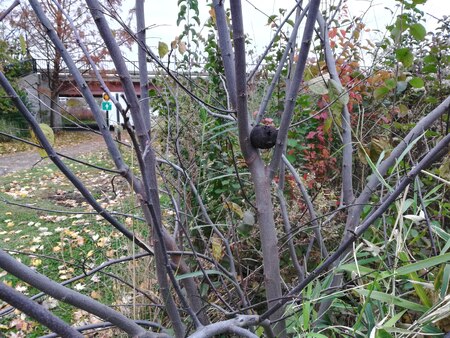
Good Natured Column: Scatter Hoarder
Pam Otto, Outreach Ambassador for the St. Charles Park District 11/8/2022 12:00PM
Years ago, as a rookie staff writer at a restaurant magazine, I had the pleasure of working with a tremendously talented senior editor named Audrey. Her wit and skill had earned her a spot near the top of the publishing food chain, yet she made herself accessible to us young cubs. If I needed a catchy headline, bam! Audrey had one. When I wondered how to phrase a photo caption, boom! In under a minute Audrey would assemble a sentence that was astute, appealing and often alliterative.
It didn’t take me long to learn that Audrey had yet another fine quality: Her cubicle was not so much a workspace as it was a pantry. Every drawer, cabinet, nook and cranny held some sort of sweet or salty treat. Candy here, chips over there, a slice of pie saved for “later.”
Audrey’s stashes—or, in ecological terms, caches—weren’t confined to her office. Perishable items (whether they’d perished or not) were stored in the communal refrigerator. She also kept a ready supply of on-the-go items--granola bars inside three-ring binders, crackers in her purse, striped peppermints in her coat pocket.
What I didn’t realize then, but is so very obvious now, is that all of us, as Audrey’s coworkers, were witnessing a very effective survival strategy. If we were squirrels, rather than frenzied writers, (and I know some would argue that the differences are minor) she would have been the most successful.
For Audrey was a scatter hoarder.
Thanks to reality TV, hoarding has gotten a bad name. But for certain animal species, hoarding, or caching, is key to their existence. Chipmunks, for example, spend much of the fall gathering nuts and seeds, which they store en masse in chambers within their burrows for use over the winter.
This method of cache forming, called larder hoarding, is the rodent equivalent of putting all their eggs in one basket. While not without its flaws, the strategy works particularly well for chippies, because their subterranean stores are harder to access and unlikely to get raided.
However gray and fox squirrels, two other Sciuridae species present in our area, have a bit of a conundrum. They have the same need to store food, but due to their ecological niche lack the means to create a large cache. They live in trees, not holes in the ground. They share territories and even nests during the winter months, but they don’t share stored food.
That’s where scatter hoarding comes in. As soon as the tree nuts begin to ripen, the squirrels start caching them. A hickory nut here, an acorn there, a walnut saved for “later.”
Research has shown that squirrels retrieve anywhere from 40% to 80% of what they cache. An impressive feat, I say—especially given that I can only remember where I put my keys about 25% of the time.
The majority of these treasures are buried, as a means of preventing other squirrels from stealing them. In fact, in areas where squirrel populations are particularly dense, you might even see an individual dig up and re-bury an item—another tactic used to foil competitors.
But every once in a while, squirrels will cache items in very obvious, above-ground locations. I’ve found butternuts on my lower level windowsills, and walnuts on the propane tank of my grill. During a recent walk at Mount Saint Mary Park in St. Charles my friends and I spied a walnut stuffed in the crotch of a small tree—one that surrounded by grasses and shrubs, not walnut trees.
At first glance, you might think that this strategy would be the antithesis of good scatter hoarding practices. That nut and all its fat- and protein-laden goodness is right there, in plain view, free for the taking.

But when put into the context of squirrels operating on spatial memory cues, the plain-sight cache makes a little more sense. The squirrel that stashed the nut there, far away from all the other nuts, is the squirrel most likely to make the trip out to get it.
That the nut was several feet off the ground is another advantage for the little scatter-hoarding Sciurus. If we get a lot of snow this winter, any nuts that are buried are going to be even harder to retrieve. But a nut stuck high in a tree—it’s low-hanging fruit, so to speak.
One of these days, winter weather is going to set in. The temperatures will drop; the precipitation will change from rain to snow. And scatter hoarders everywhere will be making use of their carefully stored provisions. Those that exhibit the most talent will be the most successful. Just like Audrey.
Pam Otto is the outreach ambassador for the St. Charles Park District. She can be reached at potto@stcparks.org

